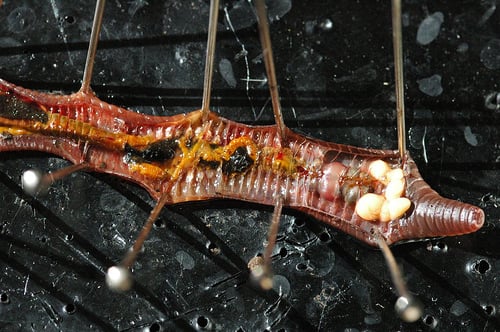On Friday, November 30, my biology 11 class and I participated in an earthworm dissection Our teacher, Ms. Ionnone brought in earthworms and we were put in groups of two. One worm per pair. We would begin this project by sticking pins into either side of the worm to stretch it out. Then we would slit the worm straight down the middle and open it up like a wardrobe. Then we pinned each side of the worm that was split down the middle to either side so we could see the insides easily. We then looked at the internal organs of the worn including the pharynx,heart, the nephridia etc. In class we studied the earthworms digestive system and how it operates. With the dissection we were able to physically view the digestive system first hand which was cool. Another system we learned about in class was the circulatory system. We were able to see the several hearts located in the worm and how they are connected. Overall, the dissection was beneficial to me after I got over the smell and how gross it looked. It expanded my knowledge on the understanding of the earthworms internal organs and systems.
1. The name that describes the pumping organs of the earthworm are aortic arches. Also known as hearts.
2. The food ingested by the earthworm primarily enters the mouth of the earthworm and then reaches the pharynx. After it reaches the pharynx it enters the esophagus. Then the food is onto the crop and after is broken down in the gizzard. The final point in which the food goes to before exited the body is the anus. This is where the worm eliminates its waste products. It is made sure throughout the tract that all nutrients are absorbed by the worm.
3. The part of the earthworm that is located directly above the pharynx is the brain which, to the rest of the body, is connected by the ventral nerve.
4. There are two parts of the earthworm excretory system that we saw. The anus, which disposes of the worms waste and the nephridia which is basically the kidney of the worm.
5. One way to find out if an earthworm eats soil is to open up its digestive track and physically see whether there is soil present.
6. The earthworms setae helps it be well-adapted to its habitat/environment because it helps the worm move throughout the dirt.

7. The earthworms digestive system is adapted to ingest large amounts of food for its size and take out all the nutrients in the food. The, the worm is able to turn the food remains into fertilizer as it is excreted from it body.
8. If we were to dissect past segment 32 what we would see is the remains of all of the intestines, anus and some of the nervous system.
9. Earthworms are hermaphroditic, meaning they posses both male and female reproduction parts. In this case they have both eggs and sperm. The worms have sperm packets inside of them as we saw in our dissection and one worm would attach to another and the egg would be passed through to the other worm and fertilized, thus reproduction would occur.








Purpose-2/4
ReplyDeleteConnection to class-3/4
Personal Reflection-2/4 Tell me what you learned, how you felt, if this activity changed how you look at the world/ biology/ the annelid...
Conventions-4/4
Requirements-9/9
Better late than never -1
19/25
If you want complete reference notes on Earthworm then go to => Reference Notes on Earthworm (Pheritima posthuma)
ReplyDelete